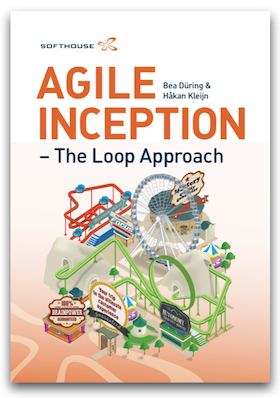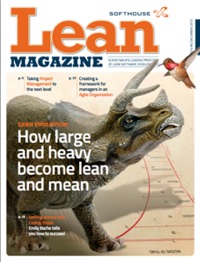A Framework for Managers in an Agile Organization
Written by Vadim Feldman, Softhouse. Based on interviewing Ola Sundin, Agile and Lean coach at Softhouse, about his ideas for the mangers framework and Vadims on experiences in introducing the framework at a customer.
“When an organization decides to become agile, they tend to forget about the managers and how it affects them. Much of the effort is focused on building cross-functional teams with competence from different departments. New roles and responsibilities are assigned and a new set of work practices is introduced.
This creates completely new challenges that few managers are prepared to cope with. The agile transformation radically changes the way the managers perform their work. The managers still need to address exactly the same issues as before. Sickness, staffing and crisis don’t just go away when the organization starts to work in an agile way” , Ola says.
Ola draws a comparison between the development team and the management team regarding the way they work and the level of support offered by the organization.
“There is not really that much difference between the way the management team and the development team operate. Both teams work with impediments and requirements on a daily basis, for fulfilling the set expectations. However instead of delivering working software the main goal of the management team is to deliver a working organization.”
Ola points out “The greatest difference is that the development team receives a high level of support from the organization for their agile transformation. They receive training, coaching, and a framework to work with on a daily basis. The management team does not have this privilege. There is no defined framework for empowering the management team to work in an agile environment neither on a daily basis, nor strategically.”
Ola has been working with management teams in both large and medium-sized organization and is often faced with the same repeating issues and challenges posed by an agile transformation. The problems can be boiled down to two questions
- How should a line manager work and behave in an agile organization?
- What tools and methods are needed for the managers to create an agile environment?
During the past 2 years Ola has been collaborating with managers from different organizations to try to find an answer to the stated questions. The result is a framework for empowering the organization to provide the same level of support for the management team as they do for the development teams.
“They still have the same tools, but the game has changed and somehow we just expect them to solve that by themselves” Ola says.
The Framework
The framework is designed to aid the management team in answering five important questions to be able to deliver a working organization. The questions are
- What is the most important thing we need to focus on for this period to succeed?
- How do we know if we are successful?
- How do we get there?
- How do we know how we are doing?
- What’s stopping us right now?
The framework is explained in the following sections along with my personal experience from an on-going implementation at a customer. I will try to provide a picture of the success stories as well as what is troubling me right now.
Thematic Goals
We usually talk about the importance of a northern star for the organization, a goal to align the organization and establish a long-term vision to strive for. This is important for creating a sense of purpose and helps build motivation for the employees however these goals are often ambiguous and spans over several years or as in some cases completely unreachable.
What’s missing is the thematic goal, the goal that is answered by the question, “What is the most important thing we need to focus on for this period to succeed?”
The thematic goal should acts as a rallying cry for the organization, aligning people to the long-term vision.
Ola Sundin points out that, “by setting and communicating the thematic goal, the expectations of what exactly the management team can deliver to the organization will be clarified”.
Vadim reflects
I have experienced some difficulties in this area, specifically since in my case there are several thematic goals that are more than valid candidates and choosing between these has proven to be difficult. However I do believe that a well-defined thematic goal will create a more streamlined chain of decisions and should aid in empowering the people to deliver results that are more in line with the company vision without any need for micromanagement.
Defining Objectives
A thematic goal can be split into defining objectives for each function area or department to assist in answering an important questions like How do we know if we are successful? What are the signs of us reaching the thematic goal?
Ola describes this set of goals as one of the more important tasks to discuss and establish for the management team when starting with the framework. While the thematic goal will operate on the organizational level and should be set one period (3 months) a head, the goals are aimed at the operational level for the people responsible of delivering the incremental results for the organization, e.g. the development team.
“The management team should allocate some time to clear out exactly how they will now that the thematic goal will be achieved. This can be a difficult task to accomplish, and can take the management team a day or two filled with discussions to complete. But in the end they will find it worth it” Ola reflects.
Vadim reflects
This is very similar to the definition of done use by the development teams. Where the team agrees upon when and to what extend their work can be considered as done. When setting the goal, it can be of some help to think about it in terms of the S.M.A.R.T. acronym, Specific, Measurable, Appropriate, Reachable, and Timely.
Organizational Development
When the thematic goal is set, the next step for the management team is to try to answer the questions How do we get there? How do we fulfil our thematic goal?
To answer these questions the management team must be able to see the current development status of the organization. This spans to everything from projects to resource allocation. Ola suggests that a visual representation of the data for each organizational area e.g. projects will effectively provide the management team with the current status information. He also suggest a practical approach by collecting relevant measurement data and creating a A3 sheet for each development area of interest and attaching it to the teams whiteboard.
“Don’t be tempted to collect and display all the data for a project. Try to find only the minimum amount of information needed for being able to aid the decision making process” Ola says.
He points out that many organizations make the mistake of visualizing everything they have on a project without questioning Who is this data for? Why should anyone care about this? Will this help me and my management team to make better decisions?
He continues, “The process of asking the right questions is essential for displaying the right information. Instead of asking what kind of data we should display, the management team should ask what kind of decisions we want to make.”
The same approach can be used for resource allocation amongst development projects. Depending on the abstraction level of the management team (e.g. middle management or managerial group) different questions will be asked and the need for managing resources will differ.
“Adapt the information and visualization techniques depending on the abstraction level of the management team,” Ola says.
Vadim reflects
It is quite easy to get stuck in this phase of the framework, to focus on bringing too much information to the table. One lesson learned is to look at the framework as something incremental, something that will change through time and just start by using the information directly available instead of digging for more.
Cadence
The framework suggests that the management team may perform the work needed on three distinct levels, operational, tactical and strategic. Each level has its own defined objectives making it the cadence of the organization, the rate everything progresses.
“The key for achieving the goals set for the organization is for the management group to start working as a high performance team. This means that they have to start trusting each other and become comfortable with addressing the issues that really matters for the organization. They have to be able to commit to deliver the expected value and hold each other accountable for doing so” Ola points out.
Operational level
The objectives for the management team on the operational level are to handle the day-to-day operations. This may include activities such as incident management and organizational maintenance, e.g. vacation and sickness administration.
Ola suggests, “The management team should start by performing a daily Gemba Walk. Visit the development teams in their work place and see for them self what is going on. Communicate with the team and give them a chance to directly raise the incident they have. This will provide the much needed level of insight for effectively making decisions and assisting the teams in their daily work.”
The framework suggests that the observed or reported incident should be handled on all of the three levels of operations. On a daily level the management team should be able to discuss and resolve the immediate issues or instead move the issues to a tactical or strategic level.
Vadim reflects
The process of incident management is similar to the Kanban method and the selection of what incidents can be looked at in respect to complexity, class of service and cost of delay.
Tactical level
Every week the management team will work on a tactical level. This level includes solving the incidents moved from the operational level, but also looking at the data and information collected from the organizational development areas to answer the questions “How do we know how we are doing?” and “What’s stopping us right now?”
Ola points out that the incidents on this level of operations are of a more severe nature to resolve and more time should be allocated to these meetings. However when the management team has found a solution for the incidents they should take the effort to communicate it to the organization effectively.
Strategic level
The strategic meeting should be held on a monthly basis and, as suggested by Ola, is 4 to 8 hours long. The focus of these meetings are still solving incidents and planning ahead based on the available data from the organization. However the abstraction level is on a much higher.
“During a strategic meeting the management team will try to find a solution for the incidents in the organization. The difference between these meetings and the one on the tactical level is that the team will only discuss one maybe two items, but will commit to find an answer during the duration of the meeting”Ola says.
Conclusion
Ola has through his collaboration with managers from different organizations developed a framework for empowering the management team to work in an agile organization.
He suggests using a thematic goal for aligning the management team and in extension the organization to focus on the most important thing for a period of time. The framework outlines how to work with organizational development by making the most important information visible for everyone involved in fulfilling the goals and the defining objectives. An operational cadence is covered for working with incidents and improvements on the operational, tactical and strategic level.
“So if an organization want’s to become agile they must provide the same level of support for the managers that they do for the development teams. It’s all about people. Managers are people to” Ola says.


